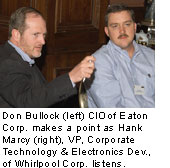
|
|
|
 |
|
 |
Collaborative Product Generation
Thought Leadership Summit on Digital Strategies May 13, 2003 - Cleveland, OH As developing and bringing new products to market becomes increasingly complex, why, how, and with whom should companies leverage collaboration? |
||
|
Press Release
Agenda
List of participants
Discussion Guide
Overview Article
Collaborative Product Generation Video
|
|||||
On May 13, the fourth Thought Leadership Summit on Digital Strategies was held in Cleveland, OH, hosted by Eaton Corporation. The roundtable discussion - "Collaborative Product Generation" - examined how companies leverage partnerships through information integration and collaboration - improving products, driving down cycle times, and reducing supply chain costs. CIOs and other senior executives from a number of Fortune 250 companies including Cargill, Cisco Systems, Eaton, General Motors, Hewlett-Packard, Staples, and Whirlpool participated in this roundtable forum, as did three academics specializing in the subject matter. Rich Karlgaard, publisher of Forbes, was the moderator and guided the group through the day.
Much of the discussion revolved around why, how, and with whom companies should leverage collaboration. Here are some key learnings from the summit that CIOs and senior executives should keep in mind as they consider collaborative product generation:
- Product design and development collaboration is in its infancy. Incentives, trust, intellectual property ownership, shared knowledge, cost pressures, and even lack of common terminology are barriers to mutually beneficial collaboration. Yet, like joint supply chain planning was ten years ago, as product collaboration gains momentum, it will hard to imagine doing business without it.
- True product collaboration is strategic, focused on creatively leveraging the knowledge and capabilities of each partner with opportunities for all to benefit. Some, so called, "collaboration" efforts are little more than tactically focused initiatives to improve efficiency and wring out costs. The resulting transactional relationships are often "destructively" driven by those who have power in the value chain.
- Many exciting collaboration initiatives involve creating complete customer solutions. Collaboration with a shared focus on the customer, a shared sense of end user needs, hones and sharpens this process, bringing clearer goals.
- Some very successful collaborative efforts have occurred between horizontal partners from different industries, avoiding the tensions within many value chains.
- Standard architectures can foster creative product generation - opposite of commonly held concerns that standardization stifles creativity. Instead it can make it easier to open strategic collaboration and enable customer flexibility at an appropriate level of product configurability while still dealing with cost concerns.
- There are many good digital tools that can greatly facilitate product collaboration within and across organizations. The biggest challenges are agreeing on which tools to use, embedding the tools in a structured development process, and then managing the use of the tools.
![]()
| To link to the Thought Leadership Summit on Digital Strategies website, click here. |